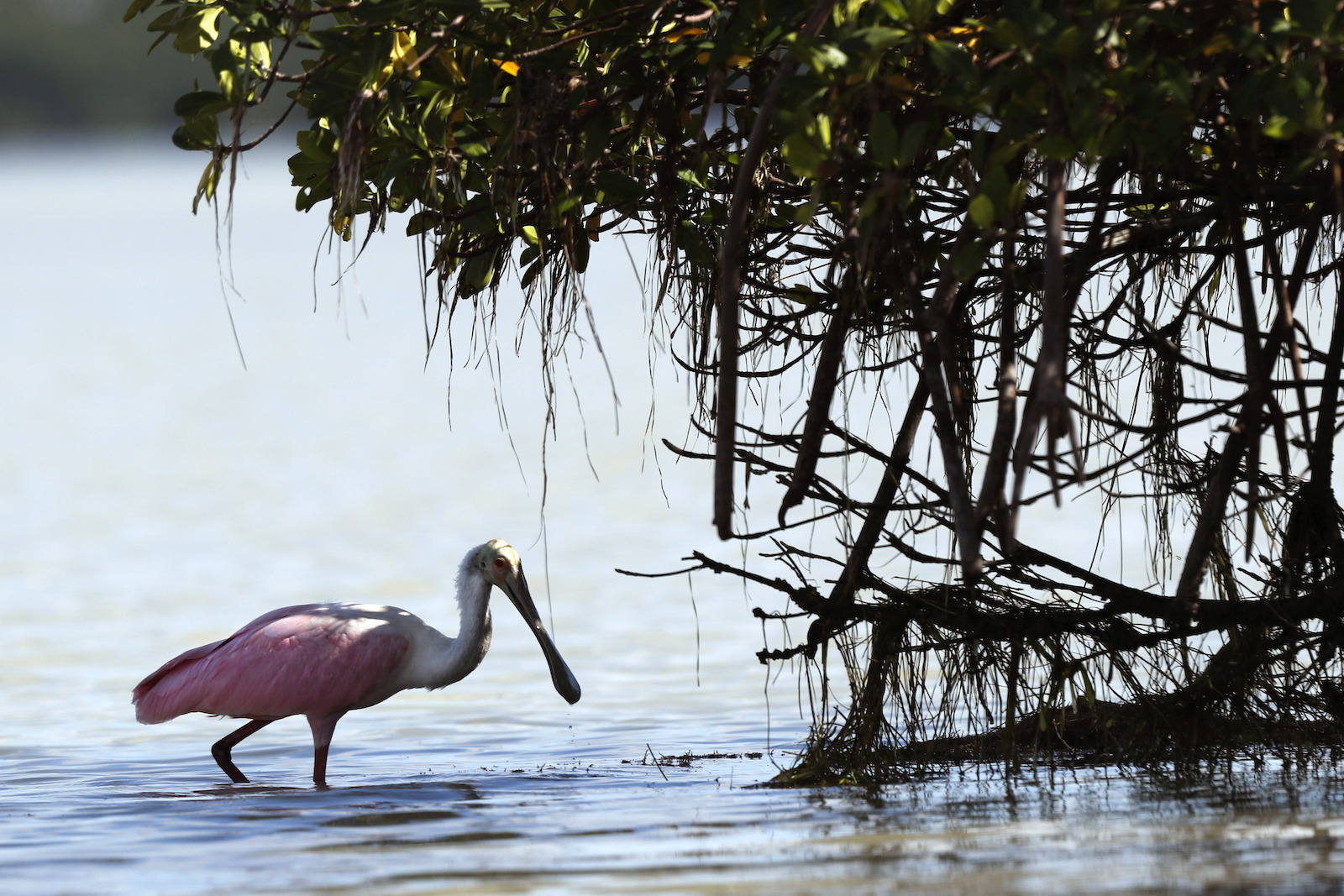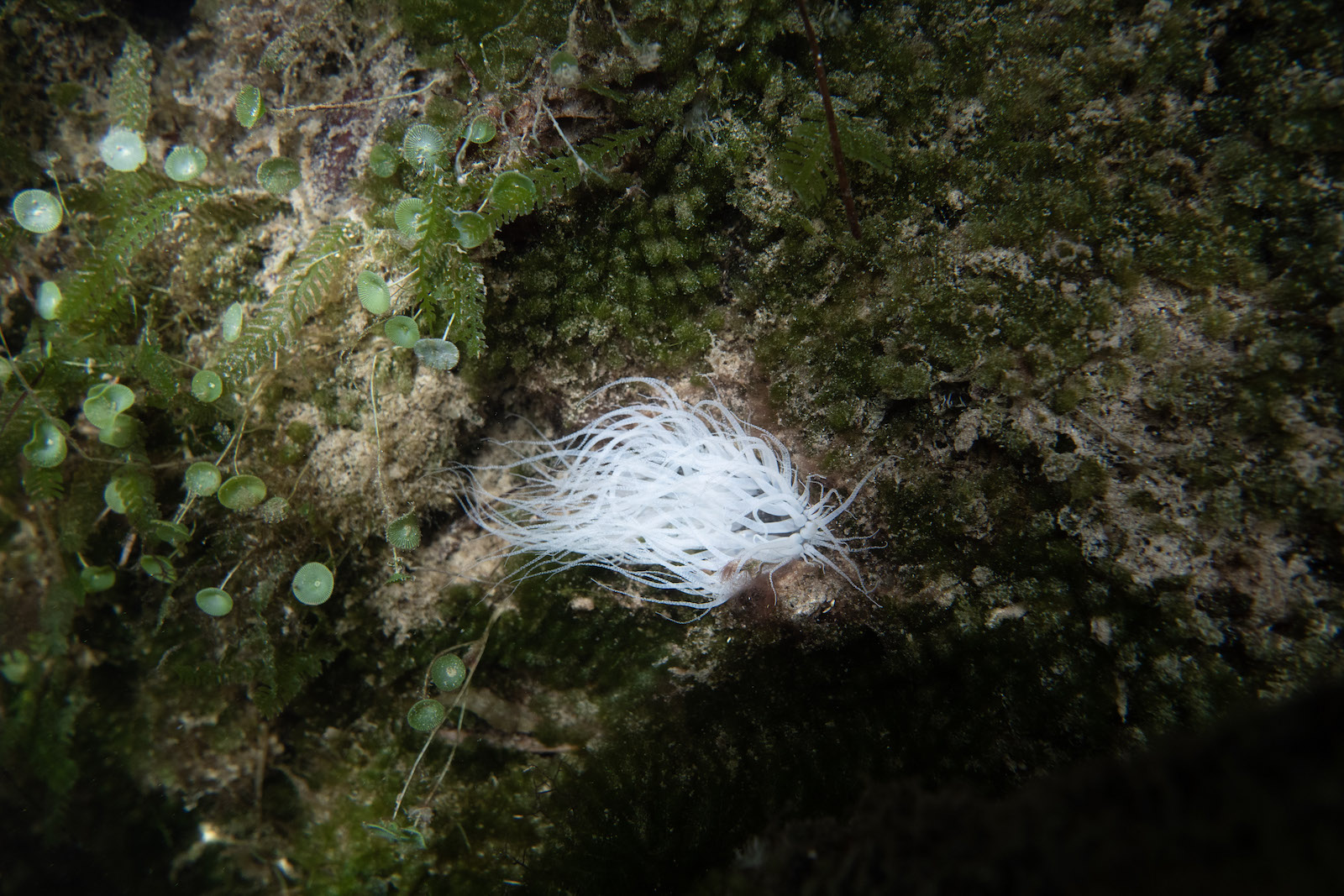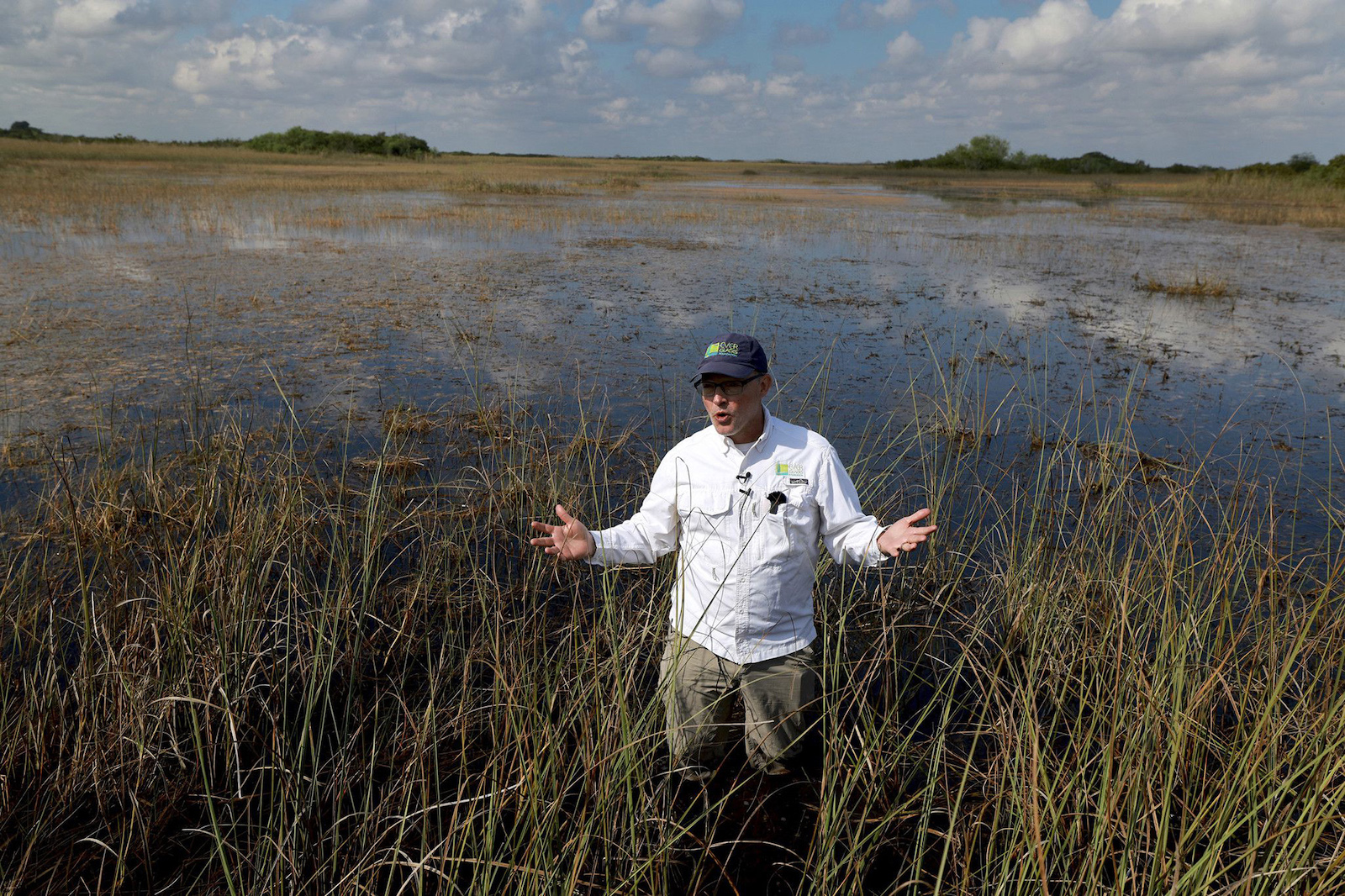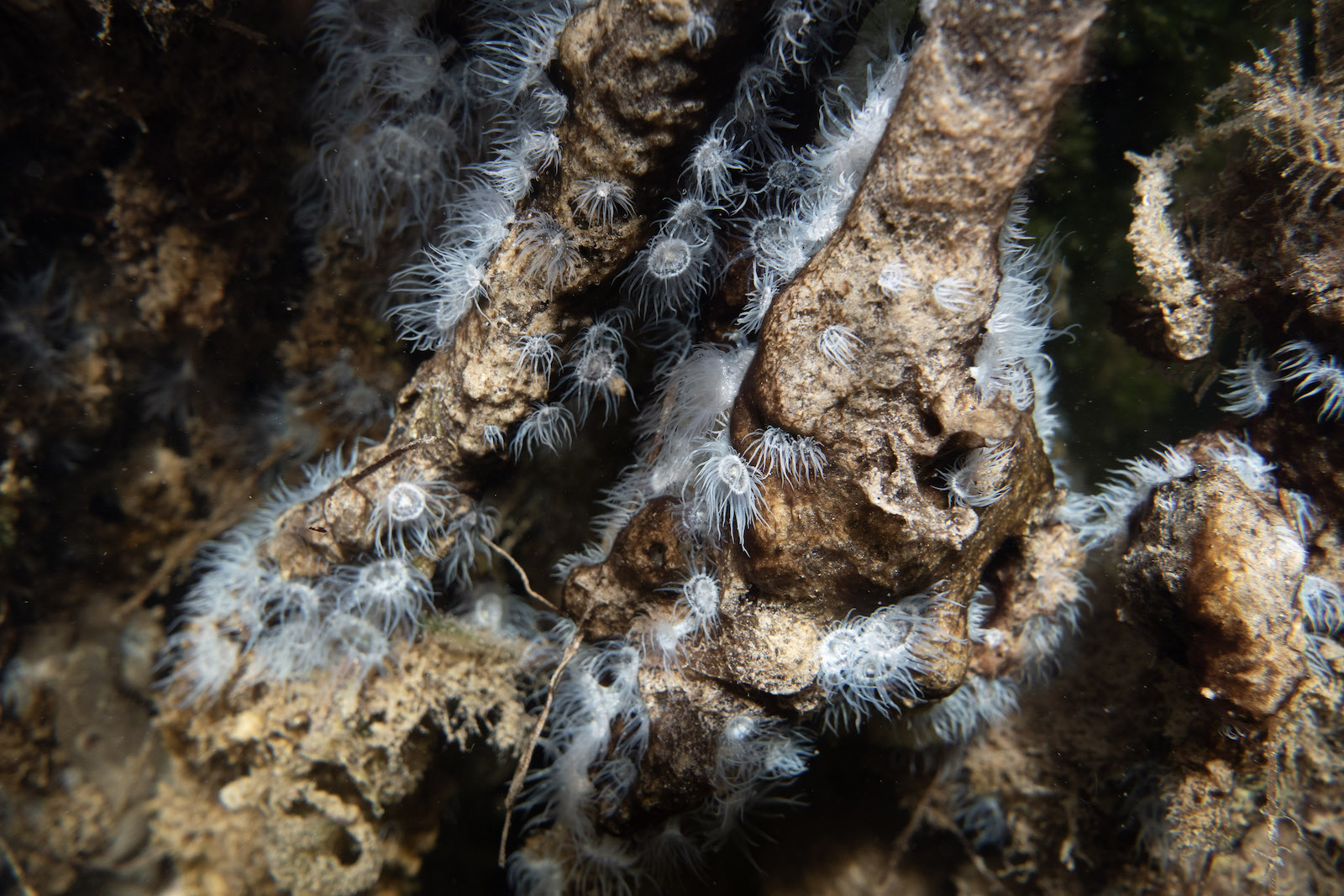This story is part of Record High, a Grist series examining extreme heat and its impact on how — and where — we live.
Summer afternoons on Florida Bay are a wonder. The sky, bright blue and dotted with clouds, meets the glassy water in a blur of blue that melts away any sign of the horizon. Wading birds rustle in the verdant branches of mangroves. Beneath the surface, fish and other creatures dart among tangled mangrove roots adorned with colorful sponges and corals. Out in the shallow flats, redfish forage for crabs, snails and shrimp hidden in fields of seagrass as manatees graze and bottlenose dolphins hunt.
But this vast estuary, which by some estimates stretches at least 800 square miles — roughly the size of Tokyo — and comprises about one-third of Everglades National Park has looked very different lately. In the mangroves, anemones and jellyfish, stressed by unprecedented water temperatures, appear ghostly white. Suffocated fish and soupy patches of dead seagrass litter the sandy flats. Sponges and coral languish beneath thick sheaths of algae.
This summer, as water temperatures across the Everglades reached triple digits, much of the nation’s attention focused on the Atlantic side of the Keys, where rapid bleaching devastated much of the Sunshine State’s beautiful coral reefs. But in Florida Bay, which sits on the west side of the Keys, many marine species have been fighting their own battle with bleaching and other effects of extreme heat, sending a strong, if silent, message about their own stress and the health of the essential habitat they inhabit.
Normally resilient creatures are struggling to survive. The record heat has not only threatened individual species – an astonishing effect on clear display in the warm South Florida waters – but the expansive and interconnected habitats, stretching from the Florida Bay to the wider Everglades and beyond.
“It’s not a grass problem, it’s not a coral problem, it’s not a sponge problem,” said Matt Bellinger, owner and operator of Bamboo Charters in the Keys. “It’s a complete ecosystem problem.”
Jerry Lorenz, the state director of research for Audubon Florida who has decades of experience in Florida Bay, likens the risks facing the estuary to playing Jenga.
“You can pull this piece, you can pull out that piece,” he said. “And you can pull out a lot more pieces. But eventually you’re gonna pull out one last piece that’s going to topple the whole thing. And that’s exactly the kind of thing we’re seeing here.”
Nestled between the southernmost end of Florida and the Keys that stretch 180 miles westward toward the Dry Tortugas, this shallow estuary features swaths of luscious seagrass. These marine prairies cover the vast majority of the Bay floor and shelter lobster, shrimp, crab, and other creatures. Thousands of mangrove islands protect juvenile reef fish, invertebrates and nesting birds like the endangered roseate spoonbill. All of them play a crucial supporting role in a much larger ecosystem. The Florida Bay is intrinsically linked to the Atlantic side of the Keys, and many fish and other species make their home in both.

Robert F. Bukaty / AP Photo
“A lot of these reef species go back into the Bay, treating it as a nursery,” said Kelly Cox, director of everglades policy at Audubon Florida. “There’s a lot of interaction between the ecosystems. So a healthy Florida Bay means healthy fish populations on the reef and vice versa. And that goes for crustaceans, it goes for sponges, it goes for all different types of fish and wildlife.”
A vibrant and productive Florida Bay does more than allow wildlife to thrive. It boosts commerce. Beyond offering ample opportunities for sport and recreational activities, the estuary supplies a bounty of seafood.
“Everything in our economy is somehow intertwined with our environment,” Cox said. “We’re talking about expansive reliance on healthy marine ecosystems in the state of Florida.”
The health of the Bay and surrounding areas declined significantly in early July during the four consecutive days that Earth experienced the hottest average global temperatures ever recorded. Weeks of intense heat, exacerbated by the lack of usual summer rain showers, saw shallower areas of the Florida Bay top 100 degrees. During the scorching weather, neighboring Manatee Bay recorded a startling water temperature of 101.1 degrees, which might be a world record. While snorkeling recently on the western edge of Florida Bay, Lorenz recalled it being too hot to swim.
“It was uncomfortable,” Lorenz said. “When I swam up under the mangroves, it was jam-packed with fish. I just had this impression go through my head that these guys are trying to stay in the shade.”

Daniel Kozin / AP Photo
The astonishing effects of the heat wave on the Bay may be partly responsible for the extensive coral bleaching and mortality seen across the reef of the Atlantic side. This year’s intense heat evaporated a lot of the Bayside’s water, leaving it extremely salty and, therefore, dense. In normal conditions, when natural currents pull the Bay water into the Atlantic, the warmer water sits on the ocean surface.
But this time, something unusual happened. The extremely hot and salty Bay water sank – a phenomenon known as a “reverse thermocline” – below the cooler Atlantic ocean water, and smothered coral reefs down to 30 feet below with its extreme temperatures, resulting in mass coral bleaching and, in some cases, instant death.
Hotter, saltier water poses a grave threat to marine species that can only withstand so much stress before their metabolic processes begin to fail. Such strain can lead to bleaching, seagrass die-offs, algal blooms, and fish kills. If the salinity of Florida Bay rises to that of the Atlantic more than 10 or 15 days a year, “it knocks the whole system out of balance,” Lorenz said.
Dramatic increases in water temperature can throw a potentially catastrophic knock to the entire ecosystem where even the most robust and resilient species, including glass anemones, relatives to coral, are fighting to survive. These common and resilient spindly invertebrates, normally difficult to see due to their brown hues, are now easily spotted in ghostly white clusters; a sign that something is very wrong.
Bleaching occurs when corals, anemones and jellyfish, pushed beyond their thermal limits, eject the algal cells in their tissues. Left without their colorful symbiotic counterparts, the animals are vulnerable to predation, starvation and disease, said Anthony Bellantuono, a biological sciences post-doctoral researcher.
In his laboratory at Florida International University, marine biologists have tested these creatures at temperatures between 89.6 and 93.2 degrees Fahrenheit. Yet, in this recent heat wave, the waters of the Bayside and southern Everglades reached heights never tested in the lab. Bellantuono has been stunned to see the widespread bleaching, which likely extended across the length of Florida Bay and beyond, among such a robust species.
“Anemones are these super resilient creatures that are highly tolerant to stress,” Bellantuono said. “It should be a bit of a concern that they’re bleached so thoroughly. They don’t bleach often and it is really, really bad when they do.”
And it’s more than animals at risk; the seagrass they nestle in and the mangroves that harbor them are threatened as well. That could reduce the amount of oxygen in the water, creating another threat for the wildlife of the Bay.

Compounding the problem, Florida Bay battles an insufficient influx of freshwater. Natural outflow across the Everglades has been significantly disrupted with much of its historic flow now diverted by canals, roads, agriculture and development – and considerably less ending up in the estuary. Insufficient freshwater to balance the influx of nitrogen, phosphorus, and other pollutants from the Gulf of Mexico, coupled with extremely hot temperatures, could leave the water uninhabitable.
Conservation organizations such as the Audubon Society have been working to educate and empower audiences to engage, through citizen science and efforts to push policymakers to act, with an environmental challenge that otherwise might seem insurmountable.
“It’s really, really hard to sit on the sidelines,” Cox said. “We’re not going to be able to pull seagrasses out of the water, right? We’re not able to pick up wading birds and move them to other locations. These are things that Mother Nature is going to have to handle on her own and we have to hope that the interventions that we’ve designed so far are enough to sustain a lifeline.”
Cox said that the northeastern portion of Florida Bay that her team covers has yet to see any seagrass die-offs this season, primarily due to long-term efforts – such as the Comprehensive Everglades Restoration Plan, the single largest restoration underway in the South Florida ecosystem – to facilitate the flow of freshwater, much of which comes from rain, through the Everglades and into the Bay.
“The mechanisms and interventions that we put in place are providing that little glimmer of hope that we might make it through this heat wave and that the seagrass beds are going to be able to hold on in the national park,” she said. “That’s really encouraging for us.”

Mike Stocker / South Florida Sun Sentinel / Tribune News Service via Getty Images
Yet, both Lorenz and Bellinger confirmed they had seen fish and seagrass die-offs in other parts of Florida Bay. And the heat is far from over. Above-average temperatures are expected over the next several months. For those in South Florida, the effects of persistent extreme heat and high water temperatures in the Florida Bay and the surrounding marine ecosystems are a sign of a potentially dire future.
“These are warnings,” says Bellantuono. “When the most tolerant creatures in our shallow waters are all bleaching, starkly white … It’s an alarm bell for these ecosystems. Will these ecosystems be as strong as they have been? It seems uncertain — when we see the ecosystem melting around us, I hope it makes people as scared as they should be about this.”
The videos in this story were created by Gabriela Tejeda

